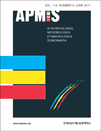Cefpodoxime 10 μg disc screening test for detection of Neisseria gonorrhoeae with mosaic PBP2 and decreased susceptibility to extended-spectrum cephalosporins for public health purposes
Abstract
Limnios A, Tapsall J, Kahlmeter J, Hogan T, Ray S, Lam A, Unemo M. Cefpodoxime 10 μg disc screening test for detection of Neisseria gonorrhoeae with mosaic PBP2 and decreased susceptibility to extended-spectrum cephalosporins for public health purposes. APMIS 2011; 119: 356–63.
Antimicrobial resistance (AMR) in Neisseria gonorrhoeae remains a global public health problem. Susceptibility to first-line treatment extended-spectrum cephalosporins (ESCs) is decreasing worldwide resulting in therapeutic failures with oral ESCs. This study describes a cefpodoxime 10 μg disc test for screening for gonococci containing a penA mosaic allele encoding a mosaic penicillin-binding protein 2 (PBP2) and decreased ESC susceptibility. Selected clinical gonococcal isolates (n = 315), containing a high proportion of gonococci with decreased ESC susceptibility and high geographical, temporal and genetic diversity, were examined using agar dilution (n = 149; cefpodoxime and ceftriaxone) and Etest (n = 315; cefixime), and disc diffusion using a commercially available cefpodoxime 10 μg disc (n = 315). penA sequencing was performed on all isolates. The 2008 WHO gonococcal reference strains (n = 8) were included as quality controls. Using a ≤11 mm annular radius of growth inhibition as the breakpoint for the cefpodoxime 10 μg disc, all 78, with exception of one isolate (13 mm), mosaic PBP2-containing isolates, which also displayed decreased susceptibility to oral ESCs, were identified. In addition, 85 non-mosaic PBP2-containing isolates (44% of which contained a PBP2 A501 alteration) had annular radii ≤11 mm and raised minimal inhibitory concentrations to the ESCs. Screening for detection of mosaic PBP2-containing gonococci and decreased ESC susceptibility, most pronounced to oral ESCs, using a commercially available cefpodoxime 10 μg disc was rapid, inexpensive and sensitive. This test can be used in AMR surveillance programmes for public health purposes especially in less-resourced settings. Further studies to refine this disc testing-based approach are in progress.




